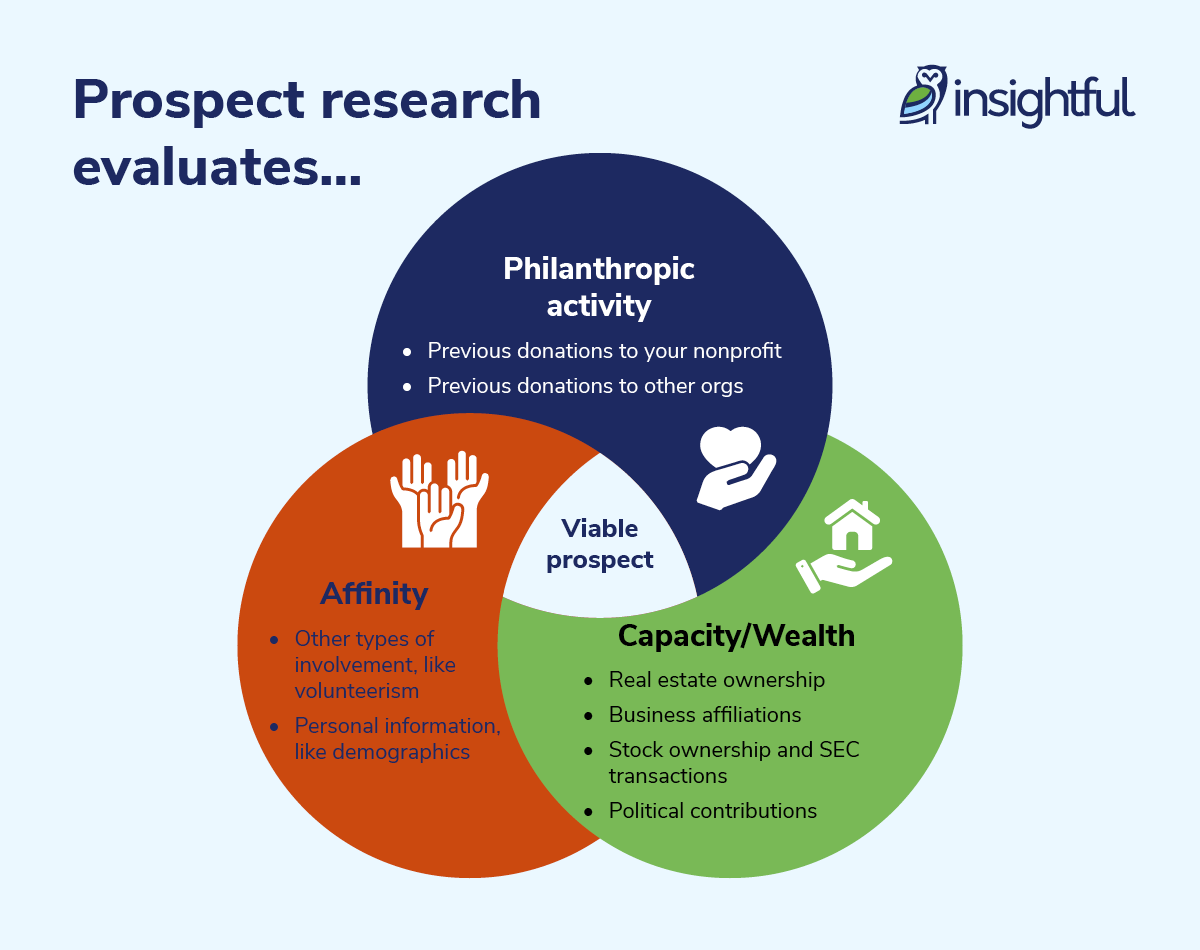How to Find High-Value Donors: 5 Steps for Nonprofits
Whether you’re looking ahead to a capital campaign, bolstering your reserve funds, or simply trying to raise more for your cause, donors are the first group you turn to. In particular, generous donors who give significant financial support can be like a jetpack on your nonprofit’s fundraising efforts, flying you toward your goals.
High-value donors, or major donors, are the individuals who make the largest contributions to your organization. Their support is critical to sustaining your nonprofit’s operations, and locating promising prospects requires a thorough strategy.
Let’s review the steps your nonprofit can take to find high-value donors and secure their support.
1. Understand the Qualifications
While each major donor is unique, there are a few common markers you can start with that signal an individual’s ability and willingness to give. According to Insightful Philanthropy, viable prospects exhibit three main indicators:

- Philanthropic activity, such as previous donations to your nonprofit or others, signals an individual’s willingness to give.
- Affinity for your cause, which could include personal details or demographic data that aligns them with your mission.
- Capacity or wealth, which indicates an individual’s ability to give, such as real estate ownership or SEC filings.
Understanding these indicators in the context of your nonprofit’s unique circumstances lays the foundation for further research. For example, certain capacity indicators will be more meaningful than others, depending on the exact amount that constitutes a major gift for your organization. If $10,000 is a major gift, you might look for donors who own stock worth this amount.
2. Analyze Your Current Donor Database
Once you’re familiar with the basic criteria, look for high-value donors among those already involved with your organization. Supporters who exhibit these criteria and already have a relationship with your nonprofit will be more likely to respond well to your fundraising appeals.
Use your donor database to identify prospects—as
DonorSearch explains, a donor database tracks your supporters’ interactions and involvement, meaning you’ll have a holistic view of each donor and the likelihood they’ll give. This way, you can contextualize philanthropic activity, affinity markers, and wealth indicators using information you’ve gathered about your supporters over time.
For example, let’s say James has supported your nonprofit for numerous years. He donates every few months, participates in volunteer activities, and has even recruited friends to join him. Throughout his involvement with your nonprofit, you’ll likely have learned his giving preferences, program interests, and other details that help you decide whether he’s a likely major giving candidate.
3. Conduct Prospect Research
After evaluating your database, it’s time to expand your search. You can still use insights from your database to guide your research—for example, if your largest donations currently come from community partners, you might research local business owners when looking for new high-value donors.
However, conducting thorough prospect research requires further analysis of real-time data. This process involves the following steps:
Acquire prospect research tools. Different solutions can flag indicators that help you identify potential major donors. Be cautious of tools that simply focus on wealth screening—you need solutions that pull data from often overlooked sources for unique insights. For example, obituary data can tell you if a recently deceased supporter’s family may be interested in making a memorial donation in their honor.- Create prospect profiles. Gather information about potential donors, such as demographic data, wealth indicators, and personal interests. Organize this data into distinct profiles so you can easily browse and act upon relevant insights.
- Develop a solicitation plan. Create personalized outreach strategies for each prospect tailored to their interests and preferences. For example, you may incorporate impact data into an appeal for prospects who advocate for similar causes to demonstrate the real change your organization is making.
Keep in mind that prospect research is an ongoing process. To ensure your data stays up-to-date and relevant, develop a system for continuous monitoring. Use prospect research tools powered by automation to deliver donor intelligence to your inbox in real-time.
4. Build Relationships and Cultivate Engagement
Think about finding high-value donors like locating lost keys—you haven’t truly “found” anything until you have the keys in hand and confirm they’re yours!
Similarly, the last step to finding high-value donors is actually securing a gift. To do so, you must
prioritize donor cultivation. Building genuine relationships is the key to turning prospects into high-value donors.
Here are some strategies to engage potential high-value donors:
Personal outreach, such as phone calls or one-on-one meetings with members of your nonprofit’s leadership team- Invitations to exclusive events, like behind-the-scenes tours of your organization’s facilities
- Regular, meaningful communication through newsletters, impact reports, and personal updates
Prospect research tools (especially those that automatically deliver real-time donor intelligence) can support your cultivation efforts long after you’ve identified a potential major donor. For example, a
donor news alert service can notify your fundraising team when prospects win awards, are involved in company purchases or sales, participate in philanthropic activities, or experience other major life events.
With these insights, your team can connect with prospects on a more personal level rather than just contacting them with a request for a major donation. Imagine how impressed your prospects will feel when you congratulate them on their recent wedding or applaud their recent volunteer efforts!
Once you’ve identified high-value donors and cultivated deep relationships with them, you’re ready to ask for their support thoughtfully. There’s no better approach to take than that of an appreciative and trustworthy organization asking for help—donors will be happy to contribute when they feel recognized by your nonprofit and confident that you’ll use their donations well.
Above all, prioritize a data-driven approach in your outreach. Leverage donor data to decide how to reach out to your prospects, impact data to craft a compelling message, and marketing data to learn which strategies were most effective. By relying on this information, you’ll develop a sturdy foundation for turning prospects into donors with ease.
About the Author
Sarah Landman
Executive Vice President, Insightful
Sarah has helped raise over half a billion dollars for nonprofits during her 20-year career. She currently serves as the Executive Vice President of Insightful, a platform that helps nonprofits stay on top of crucial donor news in order to deepen relationships and grow giving. She holds an M.A. in Philanthropy and writes and speaks on the topic of Millennial Philanthropy at regional and international conferences. Sarah was named 40 under 40 by Gulfshore Business Magazine and serves on the Board of Trustees of Saint Mary's University of Minnesota, and Catholic Charities, Diocese of Venice, FL.








































































































